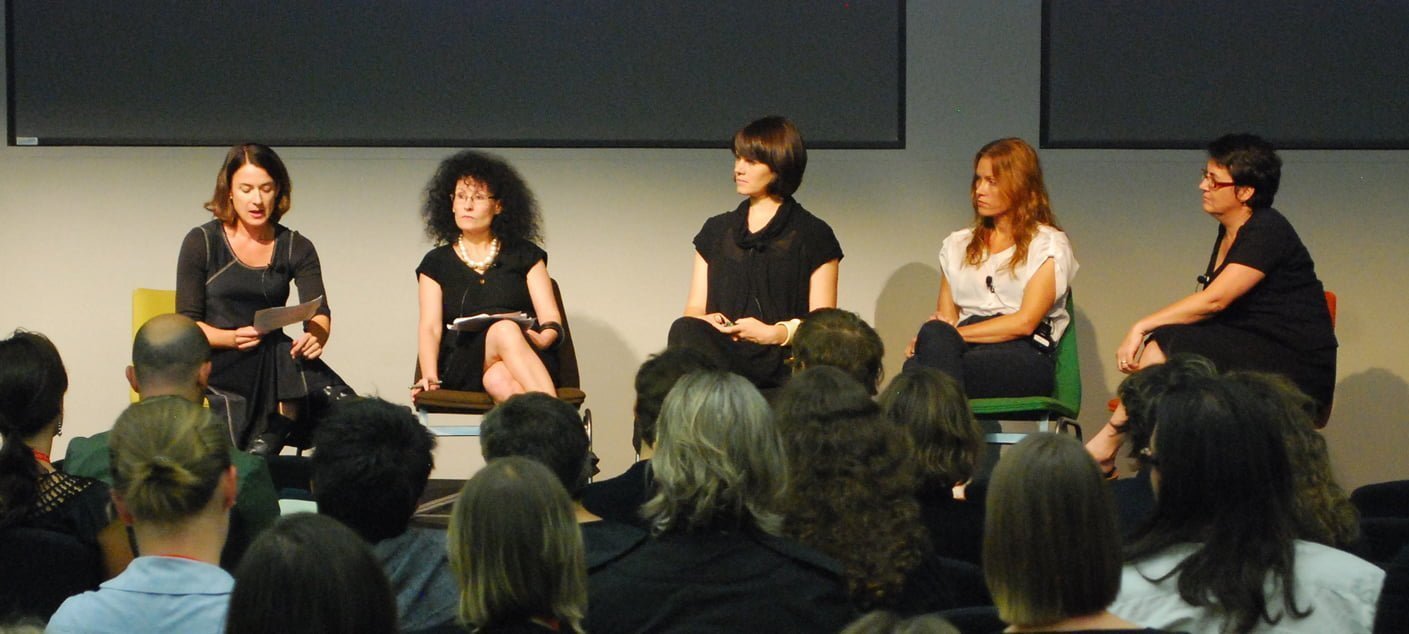Gender is over isn’t it? In this essay for a forum at Extra-Ordinary, the 2010 Australian Institute of Architects conference, Naomi Stead outlines why gender still matters and suggests that mainstream practice may have a lot to learn from the inventive modes of practice that many women have developed to make space within architecture.

Panel at Extra/Ordinary, from left to right: Sandra Kaji-O'Grady, Karen Burns, Hannah Tribe, Ninotschka Titchkosky, Justine Clark.
Setting our own house in order: women, architecture and models of practice
Women have taken an active part in architectural practice in Australia for more than a century, but remain strikingly under-represented at the highest levels of the profession today. Studies show that women are more likely to work part time or juggle diverse types of ‘marginal’ architectural work, more likely to work within government or academia, more likely to experience career interruption, more likely to leave the profession altogether, less likely to actively seek out promotion, and much less likely to occupy a senior role. But what if the particular challenges faced and overcome by many women architects could become a spur to innovation and change in the profession more broadly? What if women’s career patterns in architecture, rather than being seen as aberrant or unconventional, instead encouraged us to rethink the definition of what is an architect, what are the characteristics of architectural ‘success,’ and what other models of architectural practice might be possible? The forum will address some of these questions, and to inform and provoke that debate this essay will lay out some findings of the considerable body of international research in the field.
My own initial research was undertaken in 2008, in the making of a series of short films to encourage women to study architecture and construction funded by the Equity and Diversity Unit at the University of Technology Sydney. Of the twenty four filmed interviews we conducted, I was perhaps most struck by a comment from Professor Sandra Kaji-O’Grady, a senior academic now at the University of Sydney.
I think a lot of professionals feel that if they are good at their job then they will be advanced on merit, and that simply isn’t the case, I have never seen that occur. Women tend to have to work harder but also more strategically to make sure that the people above them know that it was them that did the job, and them that had the idea.
Kaji-O’Grady’s conviction is striking: that architecture is not the equitable meritocracy that we would all like it to be. It was also striking that Kaji-O’Grady’s stance was so different from most of the other interviewees; a more common response was articulated by Hannah Tribe, principal of Tribe Studio Architects, a small practice in Sydney now in its seventh year. Tribe was equally unequivocal:
I haven’t seen gender being an advantage or a disadvantage in my career at all in architecture. There are a lot of women studying architecture and I know that in the more powerful positions in big firms there are far fewer women than men, but in my career so far I haven’t even noticed it. I wanted to be an astronaut and a university professor when I was in second grade and all the other girls wanted to be ballerinas. So it has just been something that hasn’t ever even occurred to me.
It seemed to me that in the distinction between these two responses, from two highly intelligent and perceptive women architects, some of the larger tensions in the debate around women’s equal participation in architecture can be found. And in navigating between these two positions, I want first to go back in time.
Gender is over, isn’t it?
Once, when I was a relatively new graduate, I couldn’t see what all the fuss was about. Gender-based prejudice in architecture seemed to me a dead issue in the late nineties: I myself had never experienced nor observed a single instance of discrimination against a woman in the profession, and neither had anyone I knew. The almost complete absence of women architects from the historic canon should have been a warning, but somehow I saw this as a simple oversight, a mistake in historiographic methods that could be easily corrected from now on. I had studied under both male and female academics, in a student cohort with roughly equal gender representation. The female students had done just as well or better than the male, and the horror stories about the way that design crits used to be – sadistic, and particularly hard on women – seemed exactly that, horror stories from a past dark age. I thought that in architectural practice the bad old days probably persisted in certain regressive individuals, but that these dinosaurs would retire soon enough, and before than could be safely ignored. And in the meantime women architects were out there doing it, and very successfully: while there may have been differences in the way women operated in the profession, there was clearly no difference in the way they functioned, and this was broadly acknowledged.
Perhaps it’s not surprising that I wanted so strongly to believe in the equality of the profession. Architecture is framed – both internally and externally – as a liberal art, full of creative and progressive people, the enlightened ones on the building site. If we had a problem at all, the common wisdom went, it didn’t originate from other architects or our institutional and management structures, but rather from external forces: blokey engineers and builders and subcontractors, conservative or unsupportive clients, and perhaps also a vague, half-articulated idea of a patriarchy that wasn’t specific to architecture anyway.
It even embarrassed me a bit, back then, that gender kept arising as a concern. If we actually had gender equality in architecture, then the constant marking out of women’s experience as different and difficult seemed unhelpful – sometimes shading uncomfortably close to a victim narrative, and marginalising us as a minority group with ‘womens issues.’ Such discussions also seemed to homogenise the diversity of women’s experiences, which was a problem since a woman in a large corporate practice can have a very different work life to that of a sole practitioner, and stage of career also has a marked effect, with parenting status the biggest faultline of all. Perhaps for these reasons, some older women architects I came across were actively, even vehemently opposed to any singling out of female architects for affirmative action of any kind. I respected these women’s view, even though mine was much less militant: as a young graduate working towards a life in architectural academia, I was certain that if my gender had had any effect at all then it had been a positive one, and my female architect friends all felt the same. In short, I thought that the older feminist warriors who insisted on keeping the issue alive were well-intentioned, but so battle-scarred they didn’t know when to lay their weapons down. I thought the fight was over and we could all go home: that women had won complete equality in architecture, and could just get on with proving themselves in the job.
Continuing structural barriers
A few things happened to change my mind about all this. There was no traumatic incident, no radicalising moment of blatant injustice. There was just broad reading of the international literature, and research of my own, leading to the inevitable firm conclusion: there are gendered patterns of participation in the architectural profession, which demonstrate systematic disadvantage in the careers of women architects as a group. There are caveats: such disadvantage does not affect every individual woman; there are many examples of successful women architects working in the mainstream; some factors affect male architects just as much as female; and some factors are also common to women in other professions. Nevertheless, the research evidence of inequality for women as a group is overwhelming. As Francesca Hughes noted in 1998, ‘[t]he absence of women from the profession of architecture remains, despite the various theories, very difficult to explain and very slow to change’, while in that same year Garry Stevens wrote that ‘hidden forms of domination operate in the field of architecture,’ and that ‘there is no doubt that women particularly suffer from these mechanisms.’ It is worth rehearsing some of the findings of the research literature here in a little more depth.
In 2003 the Royal Institute of British Architects co-funded a major research project entitled Why do Women Leave Architecture? which noted a clear disparity in gender pay equity in architecture. Reading the study, it is evident that many offices in the UK are operated as virtual cottage industries, with few proper procedures for human resource management, a lack of clear paths for promotion or career progression or indeed any kind of equity policy or initiatives at all. Such offices are quite simply not professional, in the sense of having clear, consistent, well-conceived and fair procedures. They may be professional in their dealings with clients and regulatory bodies and builders, but it seems to me this means little if it is not reflected back inward, to within an architectural practice itself. Furthermore, the authors of the report found that unpaid overtime was a common way of subsidising poor business practice, and that people (often women) who were not willing to engage in these long unpaid hours were marginalised in terms of career progression and status within a company. The report shows that the lack of gender pay equity is a business management problem as much as anything – that principals and directors are too often ignorant of their obligations under equal opportunity legislation, and employees compound this through ignorance of their own rights. Pay equity itself is difficult to measure because of a lack of transparency in what relative members of an office earn, and even when this is known, the distinction in actual duties and tasks undertaken by different architects is so vast that it could explain, or disguise, an inequitable discrepancy. Anecdotally, it also seems that in situations where employees negotiate their own pay, women tend to demand less than men. Whatever the reason for that, it is a reprehensible mode of exploitation on the part of firms to take advantage of the fact that someone does not ask for what they are worth.
One key reason for women’s relatively low pay, and low representation at the upper levels of the architectural profession lies in the fact that many work part time, a pattern which is often seen to preclude more senior positions. This is an issue much broader than the architecture profession, as federal Sex Discrimination Commissioner Elizabeth Broderick, quoted in a recent article in the Sunday Age, makes clear. Arguing that part time roles and those with flexible hours would be taken more seriously by employers if more men took up these options, she says that ‘Flexible work is seen as a work practice for women with young children and a poor relation to real work, which is full-time work… Men working differently is what’s going to bring about attitudinal change in workplaces.’ The federal government has already introduced a ‘right to request’ flexible hours for both men and women in its national employment standards. It remains to be seen what effect that will have, but it is clear than top-down legislation and policy, including anti-discrimination laws and equal opportunity laws, have a role to play here. The fact that the Australian Institute of Architects does not currently have a policy on equity and diversity in the architectural workplace is also something to be addressed.
In a 2004 essay entitled ‘Women Architects and their Discontents,’ sociologists Bridget Fowler and Fiona Wilson write that ‘there are few grounds for the belief that women are on the verge of ‘making it’ in architecture,’ and that ‘the route towards equal participation of men and women in the architectural profession is likely to be arduous’. The paper draws upon an empirical study of 72 male and female architects in Scotland, and the findings are familiar: women are well represented at architecture school where they excel in their studies, but following graduation there is a progressive drop-off in numbers as ‘underlying structural constraints’ take their toll. Women architects in the study were paid less than their male counterparts, and there was a general agreement that gender inequity exists around the issue of child rearing, which has a much greater effect on women. Interestingly, both women and men in the study seemed to accept as simple necessity the idea that a woman working part time in order to look after children should have her career prospects suffer. Fowler and Wilson write that
It was universally acknowledged that having children changed the lives of female architects more than those of men. Most women architects assumed that without continuous full-time employment they would be denied equality of opportunity. Yet they tended also to minimize their losses rather than suffer a life of uncomfortable resistance: they accommodated themselves to a gendered world of work.
This is interesting, since I would hazard that similar attitudes exist in Australia. But consider this in terms of principle: is it truly acceptable that women architects should be systematically and institutionally disadvantaged in this way? Is childcare really and necessarily a task only for women? And how is it that such a ‘gendered world of work’ in architecture is so encultured that we accept it as a necessary reality? But Fowler and Wilson’s rather negative contention that the women in their study ‘tended to minimize their losses,’ and ‘accommodated themselves’ to the gendered constraints of the architectural profession also requires some further examination. A more positive attitude was uncovered by Paula Whitman, in her landmark Australian study published in 2005 as Going Places: the Career Progression of Women in the Architecture Profession.
Women redesigning architectural practice
Whitman’s report noted that at that time, women graduated from architecture in roughly equal numbers to men, yet only a tiny proportion of company directors were women. She found that women architects sometimes chose not to pursue high levels of seniority because they had ‘different career aspirations’ and felt that promotion would not lead to an increase in job satisfaction. A surprising percentage of survey respondents had declined the offer to take a more senior role at some time in their career. As Whitman noted at the time, her study was based on a specific sub-set of female architectural professionals, one which could not be taken as representative of all women in the industry. The survey was primarily distributed to existing members of the Institute, a group which could be described as professionally engaged and ‘connected’, which has a much higher than average percentage of registered architects, and where members are also more likely to be sole practitioners or self-employed. Given these qualifications, the surveyed architects reported ‘remarkably high’ levels of job satisfaction among women architects on many measures – most notably in terms of flexibility and control over work hours, level of personal autonomy, and the intellectual challenges and variety of the job.
This is far from the vision of dissatisfied and disillusioned women architects that some other studies describe, and my own research supports this guardedly optimistic view. In the interviews conducted for my film project, it was clear that women architects in mainstream practice and also those with an unconventional career pattern, all had a markedly positive view of their own agency in their working lives. Some of these women had made a deliberate choice to step out of the conventional, long-hours-for-long-years pattern typical of a project architect, and instead to move into a so-called ‘portfolio’ career mode, comprising of a range of different types of architectural work, with shorter and more discrete tasks which, not incidentally, could be more flexibly arranged around childcare. In other words, these women had re-arranged an imperfect system to better accommodate themselves. A good example of this was Shelley Penn, the Associate Victorian Government Architect at the time of the interview, whose career has been highly successful and also highly varied:
I haven’t ever really taken a straight path in architecture, and I have always had my doubts about whether I wanted to be doing architecture. So I have sort of questioned and reinvented, and having kids in a way has fit with that.
It is clear that following such a portfolio career pattern is hard work in terms of logistics and organisation, that it is sometimes precarious in its financial rewards, that opportunities for career advancement are patchy and often poor, that women in such roles rarely have the support and opportunity to engage in high-level leadership roles in the profession, and that there are significant barriers to women who wish to eventually return to a ‘mainstream’ architectural career. Nevertheless, in spite of these caveats, these women appear to have a high level of job satisfaction, and a high level of autonomy and control over their working lives. For women who are managers or directors of practice, this also extends to providing opportunities for others to work in better, more sympathetic and sustainable ways. Elizabeth Watson Brown, for example, has been running Elizabeth Watson Brown Architects for twenty years, and says:
For me, being – hopefully – a good manager is about understanding the talents and the skills of the individual clever people that you have in your organisation, and running your own practice gives you the opportunity to employ the sort of people that you want, so it is very much about understanding what those people can do, what their talents and skills are and how their lives work, what kind of time they can work, and designing the whole practice around them, you know. Everybody has things in life that they have to deal with, obligations and other things, and I think it’s really important that creative individuals have that.
One way of framing this approach is through social entrepreneurialism. An entrepreneur (from the French entreprendre – to undertake) is one who exercises initiative and pursues innovation, despite risk, in the interests of a return on investment. It can be argued that this is a role that women architects have often taken: the environment of mainstream architectural practice, whilst relatively low-risk in that it offers relatively secure employment, does so only on its own very limited terms. In order to change these terms, to invent new models of practice, it is necessary to be entrepreneurial: to take on greater risk, and demonstrate a greater level of enterprise and innovation, but where the rewards are measured in social more than financial terms.
And this brings us back, finally, to the question posed for this forum session: how can the profession as a whole benefit and learn from women architects’ experiences in architecture. In Watson Brown’s terms, the process of rethinking the way that architects work is itself a creative one, a design project, where architects should be ideally equipped to lead the way for other professions. Through this shift in frame of reference, women architects’ commonly interrupted career history, and need for flexible working conditions can be reframed not as an aberrant or problematic work pattern, but as the model for innovative new professional management paradigms in architecture. Writing in Architecture Australia in January 2006, Watson Brown noted that ‘Working women have, of necessity, had to be creative thinkers and supremely flexible and intelligent to resolve the work/life equilibrium… and it is precisely the ability to think and organize like that which makes good architects.’ Architects as professionals must set their own house in order, be more socially entrepreneurial, and work harder and more creatively towards a more equitable and balanced work life for everyone. Women architects have been pioneers in this, and it’s time their contribution was better recognised.
























1 comments
Sam says:
Jun 11, 2012
I have read this article twice over the last week. I must admit it has taken me that long to absorb some of the key points. However, after the initial slow-burn, I have come to appreciate what a fresh and valuable perspective this article brings.
On a personal note – for some years, I have avoided the architectural mainstream; its publications, awards and events – as I felt a strong pull to conform to the ‘prevailing taste culture’ as you so eloquently put it. I knew my own approach to design was in conflict with the current trends, but I found it too difficult to stand against the tide. For some time I didn’t have the confidence to fight, so I quietly retreated rather than give in to the pull.
What your article does is provide another option; a more positive way to express myself in relation to architecture. Rather than seeing my idiosyncratic approach and patchwork career as some how ‘lesser’, I can see it in terms of a ‘new model of practice’ that better suits my needs and my temperament (and my clients!). I love both the expression ‘portfolio career’ and seeing better methods of practice as a design project in and of itself. It has given me renewed confidence that I am not alone in my choices, and perhaps I may even be at the forefront of change in the profession! (Too much?)
Thankyou for your deep insights, I feel your more optimistic view of women in the profession is well-founded – and these new, more flexible, more creative, more human modes of practice WILL be the way of the future, for both women AND men.